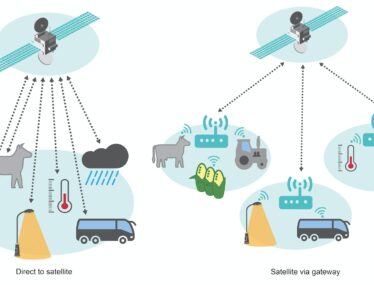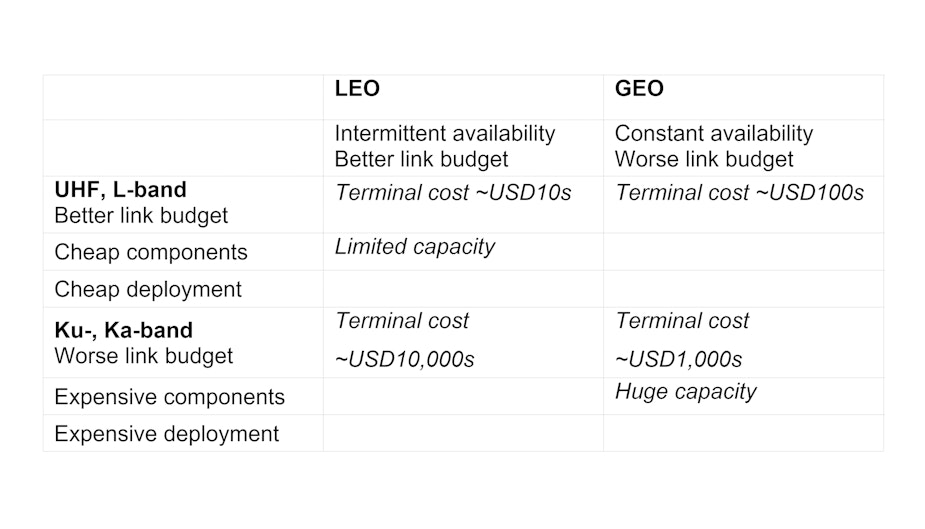Low-cost satellite IoT: around the corner, but no free lunch for operators
By Steve Baker

This blog looks at the impact of orbit and operating frequency on the types of IoT service a satellite operator can deliver. Paying attention to IoT network topology and air-interface protocols will enable all operators to make the most of the dish in front of them, says Steve Baker.
It’s probably fair to say that most, if not all, satellite IoT services aim to offer affordable, low data rate messaging, with global coverage. Global coverage has always been the satellite operator’s point of difference. Affordability has only relatively recently come into satellite conversations, especially with the advent of cubesats.
Given that a cubesat can be launched for less than the cost of a modest house in Cambridge, UK, and given that highly integrated RF components for UHF and L-band can be used to create terminals for low tens of US Dollars, it seems that affordable, global IoT services are within reach for a range of applications spanning agriculture, transport and logistics.
Configuring a satellite IoT service
In principle, low-earth orbits (LEO) offer better link budgets than geostationary (GEO) orbits, the difference in free space path loss between them being worth some 25 dB. However, it’s also worth noting that for cubesats in particular a significant portion of that advantage is lost owing to the limited gain of their small antennas.
Perhaps the more significant difference is that coverage from a LEO satellite will be intermittent unless a dense constellation is deployed. Depending on altitude and antenna pattern, an individual LEO satellite may, subject to the observer’s location, only be visible for a matter of minutes three or four times each day. In contrast a GEO satellite is nominally always available.

Daily sightings of a cubesat (inclined, polar orbit at an altitude of 450 km) from Murmansk, Cambridge, UK, and Nairobi
When it comes to operating frequency, lower bands offer better link budgets. For a given orbit, a 400 MHz link will enjoy a ~12 dB advantage over an L-band link which, in turn, will enjoy a ~19 dB advantage over a Ku-band link. However, Ku- and Ka-band services have one distinct advantage: spectrum availability. While low band operators will be deploying services in units of MHz at best, high band operators have allocations of 100s of MHz.
But in a way, in this IoT context, all of that is detail. Shannon’s law tells us that if your link budget is constrained or your bandwidth is limited, you just have to transmit your data more slowly. You’ll still be able to able to offer a non-real time, low data rate IoT service.
The really differentiating feature is that RF components are significantly cheaper for lower frequency systems and the design of UHF and L-band radios is relatively straightforward. All of this combines to deliver substantially lower device price points for low frequency band terminals than for their Ku- or Ka-band counterparts. Added to that, high frequency band antennas generally require precise alignment which means that higher deployment costs are added to higher unit costs.
Taken together, these characteristics lead us to low band devices with omnidirectional antennas that are cheap to produce and cheap to deploy for both LEO and GEO constellations. In contrast, high-band devices will require careful installation and antenna pointing, even for GEO deployments, and will require a really sophisticated (code for ‘expensive’) tracking antenna for LEO services.

What’s the upshot?
In the high bands, it therefore makes most sense to deploy a terrestrial LPWAN system, such as LoRaWAN, with a conventional VSAT terminal to backhaul data from the LPWAN gateway to an LPWAN network server. The cost of the satellite terminal will be amortised over all the LPWAN nodes in the gateway’s coverage area. With sufficient node density, the USD1,000 cost of a VSAT terminal soon becomes negligible.
In the low bands, the low cost of terminals means that direct-to-satellite makes sense. In fact, given the limited capacity of low band systems, an ‘aggregation and backhaul’ configuration might not even be feasible without a degree of edge processing and data compression.
A note of caution about cubesats
The cubesat approach of deploying low-cost, off-the-shelf technologies leads to low-cost missions and short delivery times. However, while the adoption of off-the-shelf waveforms and protocols keeps costs down it also has the potential to fundamentally limit the capacity of the systems deployed. Take a simple, aloha-based LPWAN access mechanism. It works fine for terrestrial gateways with a 10 or 20 km coverage range. But when deployed, unchanged, on a satellite, the access capacity of that single terrestrial gateway is shared across an area that covers almost all of the USA and Canada or all of Europe.
Investment in more efficient, satellite-specific protocols could double or even quadruple the system’s capacity. What’s more, that extra capacity would translate into higher revenue on each and every cubesat in the LEO constellation and – given their limited service life – on each of their replacements.CASE STUDYHow satellite network operators can reinvent themselves for the IoT
Mapping the options to markets
So how do these satellite IoT options map to the markets mentioned earlier?
High device density, time critical – demands GEO solutions
For high-density agricultural applications — such as a vineyard with 10,000 sensors deployed across a 50 km2 estate — a combination of LPWAN aggregator and GEO VSAT backhaul makes sense. The cost disadvantage of a VSAT installation can be amortised over thousands of end-nodes, to the point where it is negligible. In contrast, a direct-to-cubesat system may struggle to meet the capacity demands of such an application.
Low device density, non-time critical – best served by LEO
For low-density sensor deployment — such as CH4 measurement along remote coastlines — a direct-to-LEO satellite configuration is likely to deliver adequate performance at lowest cost and lowest power, offering a long service life on batteries and practically unlimited service with the addition of a low-cost solar supply.
Mobility
Given that transport and logistics is among the talked about use cases for satellite-enabled IoT, we must mention mobility.
To avoid the cost and complexity of antenna pointing, mobility applications are best served by low frequency services, whether LEO or GEO, that can use a low cost, omnidirectional antenna. The choice of LEO or GEO will be guided by real-time demands of the application. Do you need to track shipping containers in which one or two reports per day will be adequate? LEO is fine. Are you geofencing trucks carrying high-value loads? You need the ability to deliver near-real-time messages, you need constant connectivity, but you don’t want the cost or power consumption of a tracking antenna system. In this case, L-band GEO is the natural candidate.
Ku- or Ka-band service for mobility applications requires a tracking antenna, but despite much work on metamaterials and electronic beam steering, there are still no low cost, electronically steerable antennas on the market.
Conclusion
At first sight, it may seem surprising that many satellite operators are proposing to deliver low-cost IoT services. But on closer inspection, it’s quite clear that while the various services on offer are far from equal, there is a case to be made for each of the options on the menu. While not all satellite IoT services will succeed, there’s every reason to believe that some will. The challenge for operators and users alike is to understand what’s really being offered and to select the dish that best suits their appetite.



